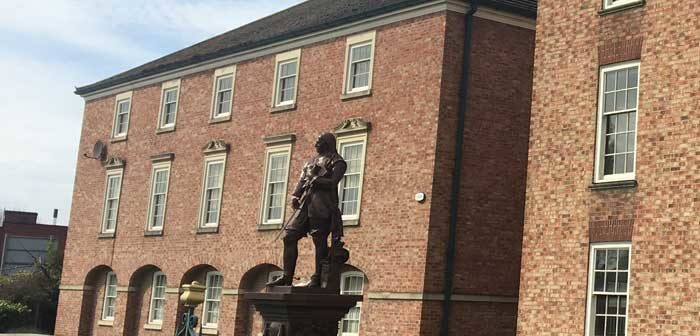HE stands alone in the heart of Warrington as the town prepares to celebrate the coronation of King Charles III. Almost a forgotten man – Oliver Cromwell.
His stony gaze is fixed on the scene of one of his great successes – Warrington Bridge where, in 1648, a Royalist Army surrendered to his New Model Army.
We are talking, of course, about the Cromwell statue which stands outside Warrington Academy – one of only five statues of the Lord Protector across the country.
He changed the course of history when he defeated the Royalists in the English Civil War – the conflict which led to the execution of Charles I in 1649.
Why does his statue stand in Warrington when so few other places have chosen to honour his memory?
Well, Warrington was generally regarded to be a Parliamentarian town during the Civil War. Cromwell himself visited the town and lodged in Church Street.
And the battle of Winwick, in 1648, was said to be the last major battle of the War. It was after this battle that the remnants of the defeated Royalist army surrendered at Warrington Bridge.
They were mostly Scots and were eventually marched back to their own country – probably along what is now Scotland Road. The local population is said to have turned out to jeer them as they left.
But there remains one further curious episode that led to the statue being erected in Warringon – and that was not until 1899.
Frederick Monks, a member of the Town Council, controversially organised the purchase and erection of the statue and gifted it to the town to mark the 300th anniversary of Cromwell’s birth.
He apparently admired much of what the Lord Protector had achieved but there were many who thought the gift inappropriate. Their objections were ignored however, and the statue still stands today.
It was moved from Bridge Street to its present position in 1981 when the Academy building was moved just 19m to make room for the construction of the Bridge Foot gyratory road scheme.
Cromwell died in 1658. Charles II, who had spent years in exile, became King of Scotland in 1649 but did not become King of England until 1660 at the Restoration of the Monarchy. He is said to have visited Warrington in 1651 – the same year he was defeated by Cromwell at the Battle of Worcester. He died of a stroke in 1685.
King Charles III has already visited Warrington three times, as Prince Charles, in 1984, 1993 and 2005.
The first occasion was to unveil the Alice in Wonderland statue in Golden Square, the second after the Warrington Bombing, when he met staff at Warrington Hospital and the third to present medals to members of the King’s Regiment and the Cheshire Regiment, when he also attended a Town Hall reception and met TA soldiers in Bank Park.




